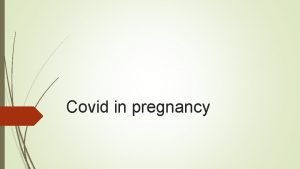Teens Pregnancy In 2017 a total of 194











































- Slides: 43


Teens & Pregnancy • In 2017, a total of 194, 377 babies were born to women aged 15– 19 years, for a birth rate of 18. 8 per 1, 000 women in this age group.


Abstinence • Only 100% method of birth control • Abstinence is when partners do not engage in sexual intercourse • Communication between partners is important for those practicing abstinence to be successful

Reasons for abstaining • • Moral or religious values Personal beliefs Medical reasons Not feeling ready for an emotional, intimate relationship • Future plans

Types of Birth Control • • Hormonal Barrier IUD Methods based on information • Permanent sterilization

Hormonal Methods • Oral Contraceptives (Birth Control Pill) • Injections (Depo-Provera) • Implants (Norplant I & II)

Birth Control Pills • • Pills can be taken to prevent pregnancy Pills are safe and effective when taken properly Pills are over 99% effective Women must have a pap smear to get a prescription for birth control pills • Pills DO NOT prevent STD’s

How does the pill work? • Stops ovulation • Thins uterine lining • Thickens cervical mucus

Positive Benefits of Birth Control Pills ü Prevents pregnancy ü Eases menstrual cramps ü Shortens period ü Regulates period üDecreases incidence of ovarian cysts üPrevents ovarian and uterine cancer üDecreases acne Side-effects • Breast tenderness • Nausea • Increase in headaches • Moodiness • Weight change • Spotting

Taking the Pill • • Once a day at the same time everyday Use condoms for first month Use condoms when on antibiotics Use condoms for 1 week if you miss a pill or take one late • The pill offers no protection from STD’s

Depo-Provera • Birth control shot given once every three months to prevent pregnancy • 99. 7% effective preventing pregnancy • No daily pills to remember

How does the shot work? • • The same way as the Pill! Stops ovulation Stops menstrual cycles!! Thickens cervical mucus

SIDE EFFECTS • Extremely irregular menstrual bleeding and spotting for 3 -6 months! • NO PERIOD after 3 -6 months • Weight change • Breast tenderness • Mood change *NOT EVERY WOMAN HAS SIDE-EFFECTS!

The Patch

IMPLANTS • Implants are placed in the body filled with hormone that prevents pregnancy • Physically inserted in simple 15 minute outpatient procedure • Plastic capsules the size of paper matchsticks inserted under the skin in the arm • 99. 95% effectiveness rate

Norplant I vs. Norplant II • Six capsules • Five years • Two capsules • Three years

Norplant Implant

Norplant Considerations • Should be considered long term birth control • Requires no maintenance • Extremely effective in pregnancy prevention > 99%

Emergency Contraception Emergency contraception pills can reduce the chance of a pregnancy by 75% if taken within 72 hours of unprotected sex This should NEVER be a primary method of contraception!!

ECP • Floods the ovaries with high amount of hormone and prevents ovulation • Alters the environment of the uterus, making it disruptive to the egg and sperm • Two sets of pills taken exactly 12 hours apart

BARRIER METHODS • • • Spermicides Male Condom Female Condom Diaphragm Cervical Cap

BARRIER METHOD • Prevents pregnancy blocks the egg and sperm from meeting • Barrier methods have higher failure rates than hormonal methods due to design and human error

SPERMICIDES • Chemicals kill sperm in the vagina • Different forms: -Jelly -Film -Foam -Suppository • Some work instantly, others require pre-insertion • Only 76% effective (used alone), should be used in combination with another method i. e. , condoms

MALE CONDOM • • Most common and effective barrier method when used properly Latex and Polyurethane should only be used in the prevention of pregnancy and spread of STD’s (including HIV)

MALE CONDOM • Perfect effectiveness rate = 97% • Typical effectiveness rate = 88% • Latex and polyurethane condoms are available • Combining condoms with spermicides raises effectiveness levels to 99%

FEMALE CONDOM • • • Made as an alternative to male condoms Polyurethane Physically inserted in the vagina Perfect rate = 95% Typical rate = 79% Woman can use female condom if partner refuses

The Female Condom The female condom is a lubricated polyurethane sheath, similar in appearance to a male condom. It is inserted into the vagina. The closed end covers the cervix. Like the male condom, it is intended for one-time use and then discarded.

Vaginal Ring (Nuva. Ring) • 95 -99% Effective A new ring is inserted into the vagina each month • Does not require a "fitting" by a health care provider, does not require spermicide, can make periods more regular and less painful, no pill to take daily, ability to become pregnant returns quickly when use is stopped. Nuva. Ring is a flexible plastic (ethylene-vinyl acetate copolymer) ring that releases a low dose of a progestin and an estrogen over 3 weeks.

DIAPRAGHM • Perfect Effectiveness Rate = 94% • Typical Effectiveness Rate = 80% • Latex barrier placed inside vagina during intercourse • Fitted by physician • Spermicidal jelly before insertion • Inserted up to 18 hours before intercourse and can be left in for a total of 24 hours

CERVICAL CAP • Latex barrier inserted in vagina before intercourse • “Caps” around cervix with suction • Fill with spermicidal jelly prior to use • Can be left in body for up to a total of 48 hours • Must be left in place six hours after sexual intercourse • Perfect effectiveness rate = 91% • Typical effectiveness rate = 80%

Cervical Cap/Diaphragm

Sponge The sponge is inserted by the woman into the vagina and covers the cervix blocking sperm from entering the cervix. The sponge also contains a spermicide that kills sperm. It is available without a prescription

INTRAUTERINE DEVICES (IUD) Both copper IUDs and hormonal IUDs prevent pregnancy by changing the way sperm cells move so they can't get to an egg. If sperm can’t make it to an egg, pregnancy can’t happen IUDs are one of the best birth control methods out there — more than 99% effective. That means fewer than 1 out of 100 people who use an IUD will get pregnant each year.

STERILIZATION • Procedure performed on a man or a woman permanently sterilizes • Female = Tubal Ligation • Male = Vasectomy

TUBAL LIGATION • Surgical procedure performed on a woman • Fallopian tubes are cut, tied, cauterized, prevents eggs from reaching sperm • Failure rates vary by procedure, from 0. 8%-3. 7% • May experience heavier periods

LAPAROSCOPY-’BAND-AID’ STERILIZATION

VASECTOMY • • Male sterilization procedure Ligation of Vas Deferens tube No-scalpel technique available Faster and easier recovery than a tubal ligation • Failure rate = 0. 1%, more effective than female sterilization

During a vasectomy (“cutting the vas”) a urologist cuts and ligates (ties off) the ductus deferens. Sperm are still produced but cannot exit the body. Sperm eventually deteriorate and are phagocytized. A man is sterile, but because testosterone is still produced he retains his sex drive and secondary sex characteristics.

Non-Medical Methods • Withdrawal • Natural Family Planning • Fertility Awareness Method

WITHDRAWAL • • Removal of penis from the vagina before ejaculation occurs NOT a sufficient method of birth control by itself Effectiveness rate is 80% (very unpredictable in teens, wide variation) 1 of 5 women practicing withdrawal become pregnant

Natural Family Planning & Fertility Awareness Method • Women take a class on the menstrual cycle to calculate more fertile times • NFP abstains from sex during the calculated fertile time • FAM uses barrier methods during fertile time • Perfect effectiveness rate = 91% • Typical effectiveness rate = 75% • No 100% safe day-irregular periods

 Definition of spotting during pregnancy
Definition of spotting during pregnancy American thyroid association guidelines pregnancy 2017
American thyroid association guidelines pregnancy 2017 Razavi
Razavi Sudahkah yang terbaik
Sudahkah yang terbaik 276-194
276-194 T'lah datang tahun baru
T'lah datang tahun baru Cs 194
Cs 194 What does the number represent in the isotope platinum-194
What does the number represent in the isotope platinum-194 Opw 710
Opw 710 Cs 194-26
Cs 194-26 276-194
276-194 Nkb 194
Nkb 194 276 bc
276 bc Nasilje u porodici clan 194
Nasilje u porodici clan 194 Nkb 167
Nkb 167 Caffeine has a molecular weight of 194
Caffeine has a molecular weight of 194 Total revenues minus total costs equals
Total revenues minus total costs equals Formula de roe
Formula de roe Total revenue minus total expenses
Total revenue minus total expenses Total revenues minus total costs equals
Total revenues minus total costs equals Total revenues minus total costs equals
Total revenues minus total costs equals One's accumulated knowledge would highlight intelligence
One's accumulated knowledge would highlight intelligence 7 habits of highly effective teens lessons
7 habits of highly effective teens lessons Nn teens
Nn teens 5 habits of highly effective
5 habits of highly effective How does digital media try to hook you
How does digital media try to hook you Love languages descriptions
Love languages descriptions 7 habits of highly effective teens quotes
7 habits of highly effective teens quotes Png
Png 7 habits of highly effective teens habit 4
7 habits of highly effective teens habit 4 The 7 habits of highly defective teens
The 7 habits of highly defective teens Love language questions
Love language questions Teens for unity
Teens for unity 7 habits of highly effective teens lesson plans
7 habits of highly effective teens lesson plans Nn teens
Nn teens Project ideas for teens
Project ideas for teens Tots tweens and teens
Tots tweens and teens Long-term goals for a teenager
Long-term goals for a teenager Sara lumholdt
Sara lumholdt Experiencing the lifespan 4th edition
Experiencing the lifespan 4th edition Grit guide for teens
Grit guide for teens Short term teenage goals
Short term teenage goals Pance blueprint
Pance blueprint Parmed-x for pregnancy
Parmed-x for pregnancy


































































